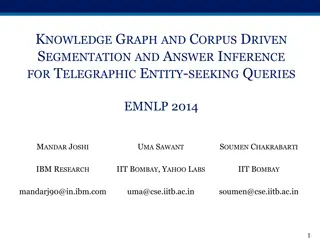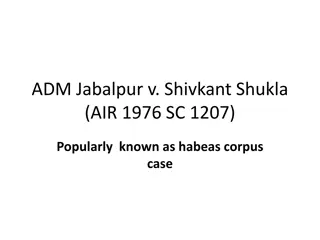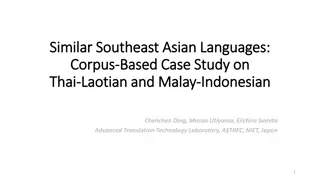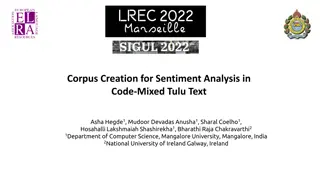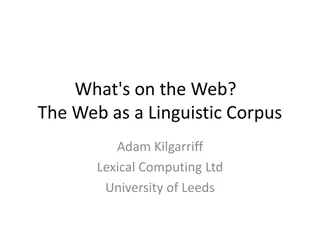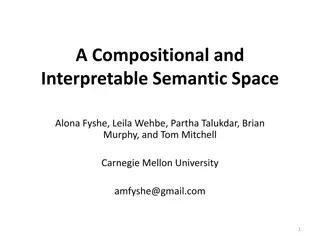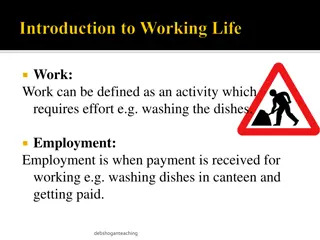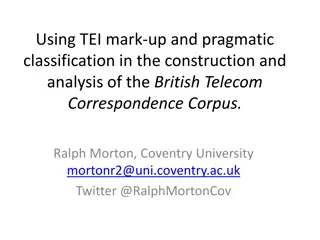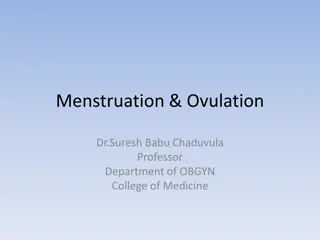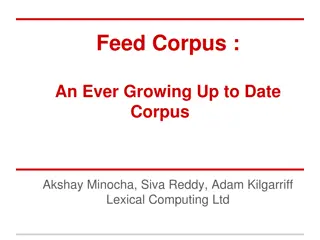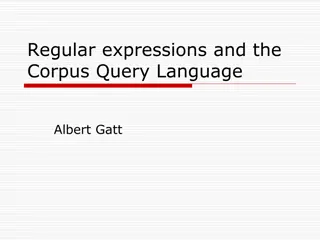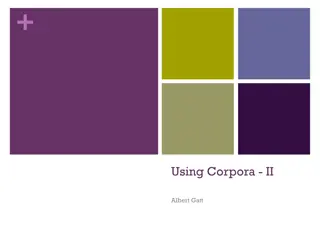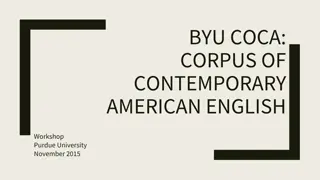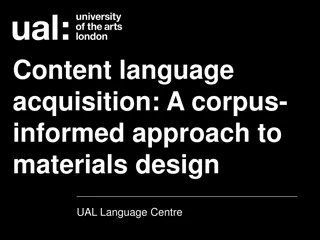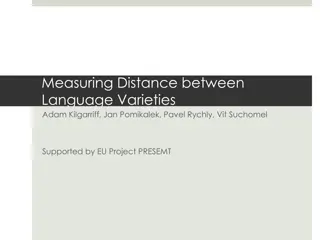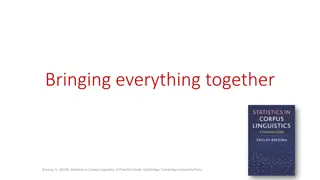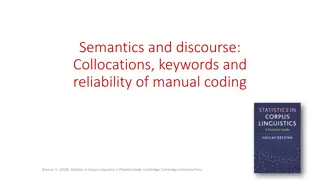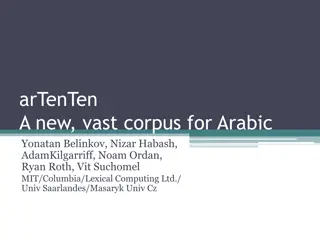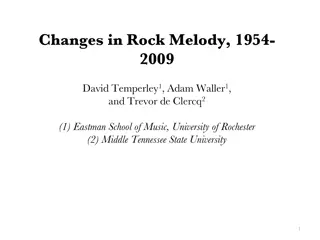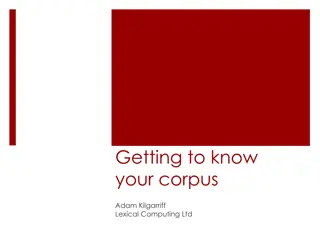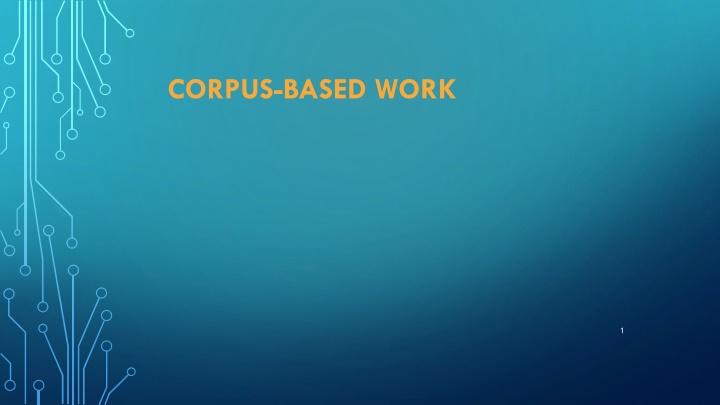
Corpus-Based Work and Text Corpora Analysis with NLTK
Learn about corpus-based work, creating lexical resources, using NLTK corpora, and analyzing text corpora. Explore the use of NLTK in accessing and analyzing various text corpora, including the Gutenberg Corpus and web/chat text. Discover how NLTK allows for the analysis of linguistic annotations in text corpora. Dive into the world of annotated text corpora and linguistic resources for language research and analysis.
Download Presentation

Please find below an Image/Link to download the presentation.
The content on the website is provided AS IS for your information and personal use only. It may not be sold, licensed, or shared on other websites without obtaining consent from the author. If you encounter any issues during the download, it is possible that the publisher has removed the file from their server.
You are allowed to download the files provided on this website for personal or commercial use, subject to the condition that they are used lawfully. All files are the property of their respective owners.
The content on the website is provided AS IS for your information and personal use only. It may not be sold, licensed, or shared on other websites without obtaining consent from the author.
E N D
Presentation Transcript
TODAY Text Corpora & Annotated Text Corpora NLTK corpora Use/create your own Lexical resources WordNet VerbNet FrameNet Domain specific lexical resources Corpus Creation Annotation 2
CORPORA A text corpus is a large, structured collection of texts. NLTK comes with many corpora The Open Language Archives Community (OLAC) provides an infrastructure for documenting and discovering language resource OLAC is an international partnership of institutions and individuals who are creating a worldwide virtual library of language resources by: (i) developing consensus on best current practice for the digital archiving of language resources, and (ii) developing a network of interoperating repositories and services for housing and accessing such resources. http://www.language-archives.org/ 3
NLTK CORPORA Gutenberg Corpus NLTK includes a small selection of texts from the Project Gutenberg electronic text archive (http://www.gutenberg.org), which contains some 25,000 free electronic books, and represents established literature NLTK: we load the NLTK package, then ask to see the file identifiers in this corpus 4
NLTK CORPORA Analyze the corpus! Example: words(), raw(), and sents() But also Conditional Frequency Distributions, Plotting and Tabulating Distributions 5
WEB AND CHAT TEXT NLTK contains less formal language as well; it s small collection of web text includes content from a Firefox discussion forum, conversations overheard in New York, the movie script of Pirates of the Carribean, personal advertisements, and wine reviews: There is also a corpus of instant messaging chat sessions with over 10,000 posts 6
ANNOTATED TEXT CORPORA Many text corpora contain linguistic annotations, representing genres, POS tags, named entities, syntactic structures, semantic roles, and so forth. Not part of the text in the file; it explains something of the structure and/or semantics of text NLTK provides convenient ways to access several of these corpora http://www.nltk.org/data http://nltk.googlecode.com/svn/trunk/nltk_data/index.xml Have a look! 7
ANNOTATED TEXT CORPORA Grammar annotation Semantic annotation See Table 2 NLTK book for more examples and pointers) Lower level annotation Word tokenization Sentence Segmentation Some corpora use explicit annotations to mark sentence segmentation. Paragraph Segmentation: Paragraphs and other structural elements (headings, chapters, etc.) may be explicitly annotated. 8
ANNOTATED TEXT CORPORA Grammar annotation Part-of-speech tags (POS): cat:NN, go: VB, and: DT etc. Next class CoNLL 2000 Chunking Data, Brown Corpus etc. Parses Dependency Treebanks, CoNLL 2007, CESS Treebanks, Penn Treebank Chunks: Text chunking consists of dividing a text in syntactically correlated parts of words. Text chunking is an intermediate step towards full parsing. For example : [NP new art critics] [VP write] [NP reviews] [PP with computers] CoNLL 2000 Chunking Data 9
ANNOTATED TEXT CORPORA Semantic annotation Genres Brown Topics Reuters Corpus Named Entities CoNLL 2002 Named Entity Example: [PER Wol] , currently a journalist in [LOC Argentina] , played with [PER Del Bosque] in the nal years of the seventies in [ORG Real Madrid] Sentiment polarity Movie Reviews Author Language Word senses SEMCOR, Senseval 2 Corpus Verb frames (eg. VerbNet) Frames (eg. FrameNet) Coreference annotations Dialogue and Discourse: dialogue act tags, rhetorical structure 10
BROWN CORPUS The Brown Corpus was the first million-word electronic corpus of English, created in 1961 at Brown University. This corpus contains text from 500 sources, and the sources have been categorized by genre, such as news, editorial, and so on. 11
BROWN CORPUS An example of each genre for the Brown Corpus (for a complete list, see http://icame.uib.no/brown/bcm-los.html) 12
BROWN CORPUS The Brown Corpus is a convenient resource for studying systematic differences between genres, a kind of linguistic inquiry known as stylistics. For example, we can compare genres in their usage of modal verbs: conditional frequency distributions of modal verbs conditioned on genre 13
REUTERS CORPUS The Reuters Corpus contains 10,788 news documents totaling 1.3 million words. The documents have been classified into 90 topics, and grouped into two sets, called "training" and "test This split is for training and testing algorithms that automatically detect the topic of a document Unlike the Brown Corpus, categories in the Reuters corpus overlap with each other, simply because a news story often covers multiple topics. 14
TEXT CORPUS STRUCTURE The simplest kind lacks any structure (i.e annotation): it is just a collection of texts (Gutenberg, web text) Often, texts are grouped into categories that might correspond to genre, source, author, language, etc. (Brown) Sometimes these categories overlap, notably in the case of topical categories as a text can be relevant to more than one topic. (Reuters) Occasionally, text collections have temporal structure (news collections, Inaugural Address Corpus) 15
BEYOND NLTK RESOURCES You can load and use your own collection of text files and local files load them with the help of NLTK's PlaintextCorpusReader Extracting Text from PDF, MSWord and other Binary Formats Processing RSS Feeds The blogosphere is an important source of text, in both formal and informal registers. With the help of a third-party Python library called the Universal Feed Parser, freely downloadable from http://feedparser.org, we can access the content of a blog Accessing Text from the Web urlopen(url).read() Getting text out of HTML is a sufficiently common task that NLTK provides a helper function nltk.clean_html(), which takes an HTML string and returns raw text. For more sophisticated processing of HTML, use the Beautiful Soup package, available from http://www.crummy.com/software/BeautifulSoup/ 16
PROCESSING SEARCH ENGINE RESULTS The web can be thought of as a huge corpus of unannotated text. Web search engines provide an efficient means of searching this text For example: [Nakov and Hearst 08] used web searches to learn a method for characterizing the semantic relations that hold between two nouns. 17
PROCESSING SEARCH ENGINE RESULTS Advantages: Size: since you are searching such a large set of documents, you are more likely to find any linguistic pattern you are interested in. Very easy to use. Disadvantages: Allowable range of search patterns is severely restricted. Search engines give inconsistent results, and can give widely different figures when used at different times or in different geographical regions. When content has been duplicated across multiple sites, search results may be boosted. The markup in the result returned by a search engine may change unpredictably, breaking any pattern-based method of locating particular content (a problem which is ameliorated by the use of search engine APIs). 18
LEXICAL RESOURCES A lexicon, or lexical resource, is a collection of words and/or phrases along with associated information such as part of speech and sense definitions. Lexical resources are secondary to texts, and are usually created and enriched with the help of texts A vocabulary (list of words in a text) is the simplest lexical resource Lexical entry A lexical entry consists of a headword (also known as a lemma) along with additional information such as the part of speech and the sense definition. Two distinct words having the same spelling are called homonyms. WordNet VerbNet FrameNet Medline 19
LEXICAL RESOURCES IN NLTK NLTK includes some corpora that are nothing more than wordlists (eg the Words Corpus) What can they be useful for? There is also a corpus of stopwords, that is, high-frequency words like the, to and also that we sometimes want to filter out of a document before further processing. Stopwords usually have little lexical content, and their presence in a text fails to distinguish it from other texts. 20
REFERENCE Christopher Manning, http://nlp.stanford.edu/manning/

